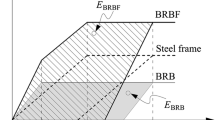Abstract
The main purpose of this study is to respond to an important question in the field of structural engineering: is the seismic collapse capacity of optimally designed concentrically steel braced frames acceptable or not? The present work includes two phases: performance-based design optimization and seismic collapse safety assessment. In the first phase, three nature-inspired metaheuristic algorithms, namely improved fireworks algorithm, center of mass optimization, and enhanced colliding-bodies optimization are employed to carry out the optimization task. In the second phase, seismic collapse capacity of the optimally designed concentrically steel braced frames is evaluated by performing incremental dynamic analysis and generating fragility curves. Two design examples of 5- and 10-story concentrically steel braced frames with two different topologies of braces are presented. The numerical results indicate that the center of mass optimization algorithm outperforms the other algorithms. However, all of the optimal designs found by all algorithms are of acceptable seismic collapse safety.













Similar content being viewed by others
References
ASCE-41-13 (2014) Seismic evaluation and retrofit of existing buildings. American Society of Civil Engineers, Reston
Fragiadakis M, Vamvatsikos D, Karlaftis MG, Lagaros ND, Papadrakakis M (2015) Seismic assessment of structures and lifelines. J Sound Vib 334:29–56
Gholizadeh S, Fattahi F (2019) Multi-objective design optimization of steel moment frames considering seismic collapse safety. Eng Comput (In press). https://doi.org/10.1007/s00366-019-00886-y
Hassanzadeh A, Gholizadeh S (2019) Collapse-performance-aided design optimization of steel concentrically braced frames. Eng Struct 197:109411
Degertekin SO, Tutar H, Lamberti L (2020) School-based optimization for performance-based optimum seismic design of steel frames. Eng Comput (In press). https://doi.org/10.1007/s00366-020-00993-1
Bertero VV (1977) Strength and deformation capacities of buildings under extreme environments. Struct Eng Struct Mech 53:29–79
Bazzurro P, Cornell CA (1994) Seismic hazard analysis of nonlinear structures. I: methodology. J Struct Eng 120:3320–3344
Vamvatsikos D, Cornell CA (2002) Incremental dynamic analysis. Earthq Eng Struct Dyn 31(3):491–514. https://doi.org/10.1002/eqe.141
Vamvatsikos D, Cornell CA (2004) Applied incremental dynamic analysis. Earthq Spectra 20:523–553
Brunesi E, Nascimbene R, Parisi F, Augenti N (2015) Progressive collapse fragility of reinforced concrete framed structures through incremental dynamic analysis. Eng Struct 104:65–79
Wijesundara KK, Bolognini D, Nascimbene R, Calvi GM (2009) Review of design parameters of concentrically braced frames with rhs shape braces. J Earthq Eng 13:109–131
Wijesundara KK, Nascimbene R, Rassati GA (2018) Evaluation of the seismic performance of suspended zipper column concentrically braced steel frames. J Constr Steel Res 150:452–461
Gholizadeh S, Milany A (2018) An improved fireworks algorithm for discrete sizing optimization of steel skeletal structures. Eng Optim 50:1829–1849
Gholizadeh S, Ebadijalal M (2018) Performance based discrete topology optimization of steel braced frames by a new metaheuristic. Adv Eng Softw 123:77–92
Kaveh A, Ilchi Ghazaan M (2014) Enhanced colliding bodies optimization for design problems with continuous and discrete variables. Adv Eng Softw 77:66–75
FEMA P-695 (2009) Quantification of building seismic performance factors. Federal Emergency Management Agency, Washington (DC)
OpenSees (2012) Version 2.4.0. PEER, Berkeley
MATLAB (2016) The Language of Technical Computing. The MathWorks Inc.
AISC-LRFD (2001) Manual of steel construction: load & resistance factor design, 2nd edn. American Institute of Steel Construction, Chicago
Vanderplaats G (1984) Numerical optimization techniques for engineering design: with application. McGraw-Hill, New York
Tan Y, Zhu Y (2010) Fireworks Algorithm for Optimization. Springer, Berlin
Tan Y (2015) Fireworks Algorithm, A Novel Swarm Intelligence Optimization Method. Peking University, Beijing
FEMA-274 (1997) NEHRP commentary on the guidelines for the seismic rehabilitation of buildings. Federal Emergency Management Agency, Washington, DC
Author information
Authors and Affiliations
Corresponding author
Additional information
Publisher's Note
Springer Nature remains neutral with regard to jurisdictional claims in published maps and institutional affiliations.
Rights and permissions
About this article
Cite this article
Gholizadeh, S., Hassanzadeh, A., Milany, A. et al. On the seismic collapse capacity of optimally designed steel braced frames. Engineering with Computers 38, 985–997 (2022). https://doi.org/10.1007/s00366-020-01096-7
Received:
Accepted:
Published:
Issue Date:
DOI: https://doi.org/10.1007/s00366-020-01096-7




